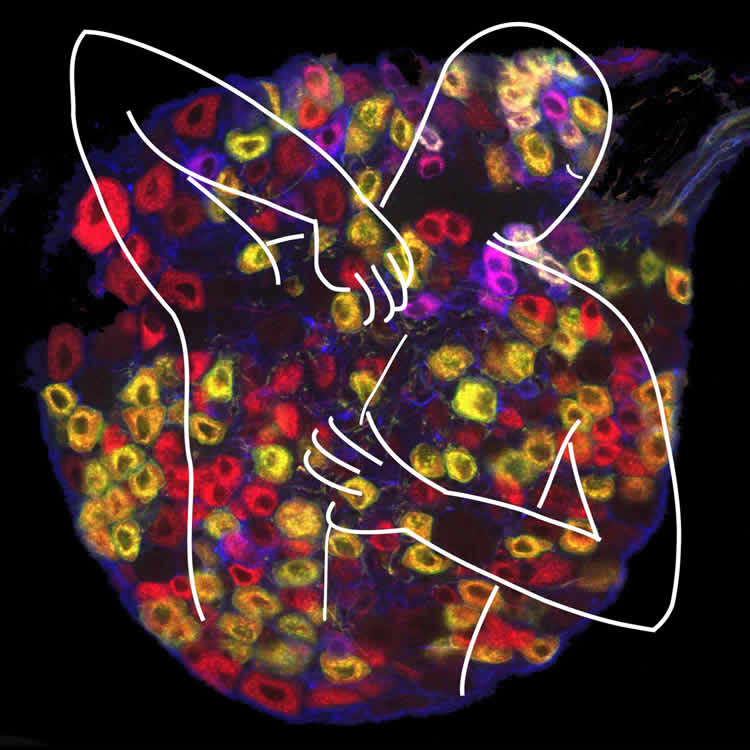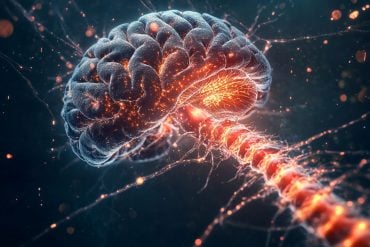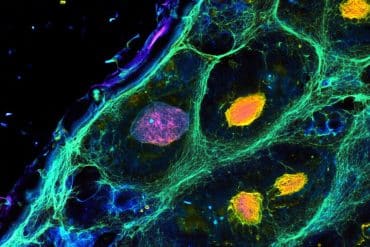Summary: Study could help explain how pain often follows a chemical induced itch.
Source: Cell Press.
There are neurons in your skin that are wired for one purpose and one purpose only: to sense itchy things. These neurons are separate from the ones that detect pain, and yet, chemical-induced itch is often accompanied by mild pain such as burning and stinging sensations. But when it comes to sending signals toward your brain through your spinal cord, itch and mild pain can go through the same set of spinal cord neurons, researchers report February 22 in Neuron. This finding explains why pain often accompanies intense chemical-induced itch.
“To our surprise, we found the spinal cord neurons receiving the peripheral pain and itch inputs are not separate. They can receive signals from itch fibers and also pain fibers,” says study coauthor and neuroscientist at Johns Hopkins University Xinzhong Dong. These neurons, called the GRP neurons, are a way station for pain and itch signals on their way to the brain.
However, GRP neurons are not passive conduits, the researchers found. “When we eliminate this population of neurons in mice, the itch response is reduced. They scratch less,” says the study’s first co-author Shuohao Sun, a graduate student at Hopkins. “But at the same time, the pain response is actually increased.”
Mice without GRP neurons spent more time rubbing and licking to alleviate their pain, induced, for example, by exposing their tails to hot water. Further experiments that tracked electrical signaling through the neurons corroborated the result. Even though the GRP neurons seemed to be forwarding mild pain signals to the next neural relay station, they also seemed to mitigate intense pain signals.
“It might sound counterintuitive, but we suggest that this small group of cells actually functions like a braking system for pain,” says Sun. “This brake is not always triggered by the painful stimuli; it’s only triggered by the strong pain stimuli. When the brake is on, the signal doesn’t go through. But when you have a weak pain signal, it doesn’t trigger the brake and the signal can go through.” The researchers have named this hypothesis “the leaky gate” model.

When the mice’s GRP neurons have been destroyed, the brake lines have essentially been cut, resulting in an uncontrolled cascade of pain. The braking system may be a way for animals to detect mild pains–like the kinds associated with itchy substances–without becoming overwhelmed by the pain, the researchers say. Built-in pain management would likely be a helpful adaptation for escaping from predators while injured.
At the same time, GRP neurons are not the only group of spinal cord neurons that receive and forward pain signals toward the brain, and the brain itself plays a central role in translating signals from peripheral neurons into experienced sensation. Questions remain about what happens to the signals from GRP neurons after they’re transported up the spinal cord.
Chronic pain and itch affect about 1 in 10 Americans, the authors say. A better understanding of pain and itch signals’ journey to the brain may lead to new treatment options, eventually. “The next step is moving even further into the central nervous system and seeing how the signal from the secondary neuron is getting to the next relay station,” says Dong. “We go one step at a time.”
Funding: The work was supported by grants from the US National Institutes of Health. Xinzhong Dong is a Howard Hughes Medical Institute investigator.
Source: Diana Crow – Cell Press
Image Source: NeuroscienceNews.com image is credited to Xinzhong Dong.
Original Research: Full open access research “Leaky Gate Model: Intensity-Dependent Coding of Pain and Itch in the Spinal Cord” by Shuohao Sun, Qian Xu, Changxiong Guo, Yun Guan, Qin Liu, and Xinzhong Dong in Neuron. Published online February 22 2017 doi:10.1016/j.neuron.2017.01.012
[cbtabs][cbtab title=”MLA”]Cell Press “Itch Neurons Play Role in Pain Management.” NeuroscienceNews. NeuroscienceNews, 22 February 2017.
<https://neurosciencenews.com/itch-neuron-pain-6145/>.[/cbtab][cbtab title=”APA”]Cell Press (2017, February 22). Itch Neurons Play Role in Pain Management. NeuroscienceNew. Retrieved February 22, 2017 from https://neurosciencenews.com/itch-neuron-pain-6145/[/cbtab][cbtab title=”Chicago”]Cell Press “Itch Neurons Play Role in Pain Management.” https://neurosciencenews.com/itch-neuron-pain-6145/ (accessed February 22, 2017).[/cbtab][/cbtabs]
Abstract
Leaky Gate Model: Intensity-Dependent Coding of Pain and Itch in the Spinal Cord
Highlights
•Grp+ neurons receive monosynaptic input from both pain and itch primary neurons
•Intensity-dependent coding of pain by Grp+ neurons
•Grp+ neurons form “leaky gate” to negatively regulate pain transmission
•Loss of Grp+ neurons decreases itch and increases pain
Summary
Coding of itch versus pain has been heatedly debated for decades. However, the current coding theories (labeled line, intensity, and selectivity theory) cannot accommodate all experimental observations. Here we identified a subset of spinal interneurons, labeled by gastrin-releasing peptide (Grp), that receive direct synaptic input from both pain and itch primary sensory neurons. When activated, these Grp+ neurons generated rarely seen, simultaneous robust pain and itch responses that were intensity dependent. Accordingly, we propose a “leaky gate” model in which Grp+ neurons transmit both itch and weak pain signals; however, upon strong painful stimuli, the recruitment of endogenous opioids works to close this gate, reducing overwhelming pain generated by parallel pathways. Consistent with our model, loss of these Grp+ neurons increased pain responses while itch was decreased. Our new model serves as an example of non-monotonic coding in the spinal cord and better explains observations in human psychophysical studies.
“Leaky Gate Model: Intensity-Dependent Coding of Pain and Itch in the Spinal Cord” by Shuohao Sun, Qian Xu, Changxiong Guo, Yun Guan, Qin Liu, and Xinzhong Dong in Neuron. Published online February 22 2017 doi:10.1016/j.neuron.2017.01.012






